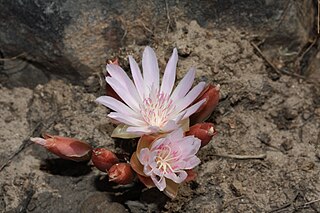
Bitterroot is a small perennial herb in the family Montiaceae. Its specific epithet rediviva refers to its ability to regenerate from dry and seemingly dead roots.
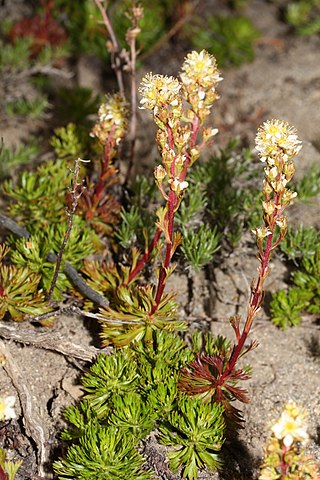
Luetkea is a genus of herbaceous plants in the family Rosaceae. One species is accepted. Luetkea pectinata is a mat-forming semi-shrub. It is endemic to the cold portions of western North America occurring in subarctic Alaska, Yukon, western Northwest Territories, and subalpine to alpine regions of British Columbia, southwestern Alberta, Washington, Oregon, Idaho, northern California and western Montana.
Potentilla saxosa, commonly known as rock mousetail and rock ivesia, is a species of flowering plant in the rose family. It is native to the mountains and deserts of central and southern California and northern Baja California, where it grows in cracks and crevices in rock faces and slopes.

Lomatium columbianum is a perennial herb of the family Apiaceae known by the common names purple leptotaenia and Columbia desert parsley. It is endemic to the U.S. states of Oregon and Washington, mostly along the Columbia River east of the Cascades.

Lomatium cuspidatum is a perennial herb of the family Apiaceae, native to the U.S. state of Washington. It is found primarily on open rocky slopes in the Wenatchee Mountains, strongly associated with serpentine scree and soils.

Potentilla diversifolia or Potentilla × diversifolia is a species of flowering plant in the Rose Family (Rosaceae) known by the common names varileaf cinquefoil, different-leaved cinquefoil, and mountain meadow cinquefoil.
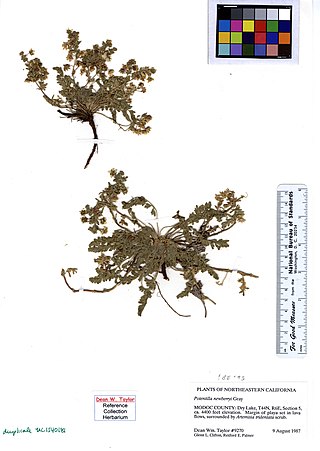
Potentilla newberryi is a species of cinquefoil known by the common name Newberry's cinquefoil. It is native to the Pacific Northwest of the United States from Washington to the northeastern Modoc Plateau in California and Nevada.

Castilleja septentrionalis is a species of Indian paintbrush known by several common names, including northern paintbrush, sulfur paintbrush, and pale painted cup. There is taxonomic disagreement as to if it is one species widely distributed in mountain and alpine environments of North America or if there is a second species, Castilleja sulphurea, in the Rocky Mountains.
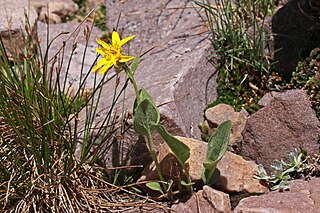
Arnica rydbergii is a North American species of flowering plant in the family Asteraceae, known by the common name Rydberg's arnica or subalpine arnica or subalpine leopardbane. It is native to western Canada, and the western United States.

Erigeron tweedyi, or Tweedy's fleabane, is a perennial herb in the family Asteraceae. It is native to the Rocky Mountains in Montana, Idaho and Wyoming.

Frank Tweedy (1854–1937) was an American topographer and botanist. He worked on pioneering surveys first in the Adirondacks, and then in the American West. He also made major contributions to our knowledge of the western flora and vegetation. He is perhaps best known for his studies in Yellowstone National Park.

Astragalus tweedyi, or Tweedy's milkvetch, is a perennial herb in the pea family. It is native to Washington and Oregon in the Pacific Northwest of the United States.
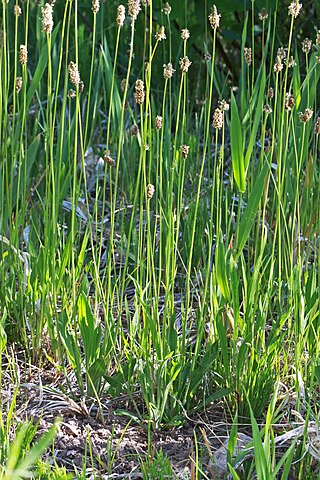
Plantago tweedyi, Tweedy's plantain, is a perennial herb in the plantain family. It is native to the western United States, from New Mexico and Arizona north to Montana.

Chionophila tweedyi, or Tweedy's snowlover, is a perennial herb in the plantain family. It is native to Idaho and Montana in the western United States.

Calamagrostis tweedyi, the Cascade reedgrass or Tweedy's reedgrass, is a perennial in the grass family. It is native to the Pacific Northwest in the United States, in Washington, Oregon, Idaho, and Montana.
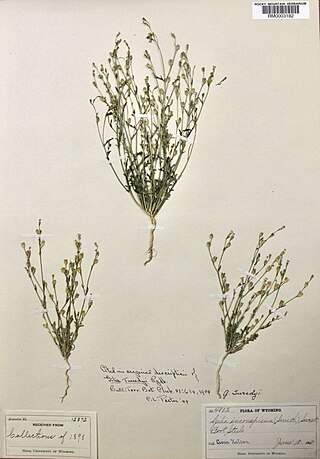
Gilia tweedyi, or Tweedy's gilia, is an annual plant in the phlox family. It is native to the northwestern United States.

Salix tweedyi, or Tweedy's willow, is a shrub in the willow family. It is native to the northwestern United States.

Kelseya is a monotypic genus of flowering plants belonging to the family Rosaceae. The only species is Kelseya uniflora. It is commonly called the oneflower kelseya, spiraea or alpine laurel. The genus was named in honor of Francis Duncan Kelsey, a Montana resident botanist, who discovered the plant in 1888 at the "Gate of the Mountains" near Townsend.

Drymocallis fissa, the bigflower cinquefoil, also known as the leafy cinquefoil, leafy drymocallis, or wood beauty, is a small plant also sometimes classified as Potentilla fissa. It is a herbaceous plant with a thick taproot known for its moderately hairy leaves, redish leaf stems, and relatively large yellow flowers. It is native to foothills and lower mountains the Rocky Mountain region in the western United States.


















